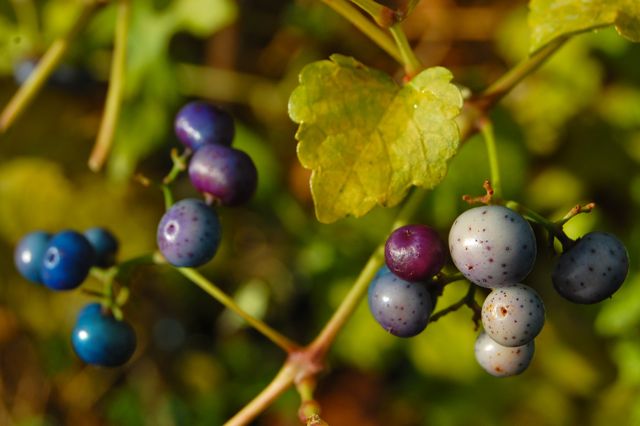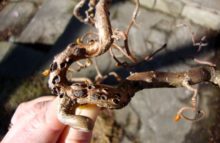| Oh, how I love those mouthful names: Ampelopsis brevipedunculata |
Its pretty, many-coloured blue and purple berries give porcelain vine its name. I had one of these members of the grape family – the one with the variegated leaves – in the wrong spot in my garden. Please note the use of the past tense. It’s a lovely vine “when well grown.” I couldn’t resist snapping a shot of these at the Wychwood Barns.
But, drat! Unfortunately, it’s another lovely non-native vine, like Hall’s honeysuckle (Lonicera japonica ‘Halliana’), that’s a little too free with its seeding habits. Birds and critters eat the berries and sprinkle the seeds around with their doings. In the right conditions, these fast-growing vines can get a stranglehold on native spaces.
In many states of New England, immediately across the Great Lakes, Ampelopsis is classed as an invasive exotic species. In Ontario, it’s on the watch list [PDF] [Update: in 2016, this link is now a dead end]. Warmer parts of the province might be most at-risk. With warming lake-effect and sheltered microclimates, that includes pockets of the city.
So please be careful, especially if you live near wild areas, as many of us in Toronto do. Little shards of porcelain vine would not be great to have flying off (and up) in unwanted directions.





3 comments
Several of these were planted along the north fence when we moved into our property ten years ago. Seedlings popped up over the yard and they attracted Japanese Beetles by the droves. I dug out the base vines over six years ago, and I still have seedlings occasionally pop up in the garden. Invasive is too gentle a word for this vine.
The berries are beautiful, though.
thanks for posting the invasive / conservation info!
It's a beauty! I like to keep an eye on what's being 'watched' by adjoining states since Tennessee seems slow to recognize invasives. If you ever come to Nashville you'll see a city covered up with honeysuckles! gail